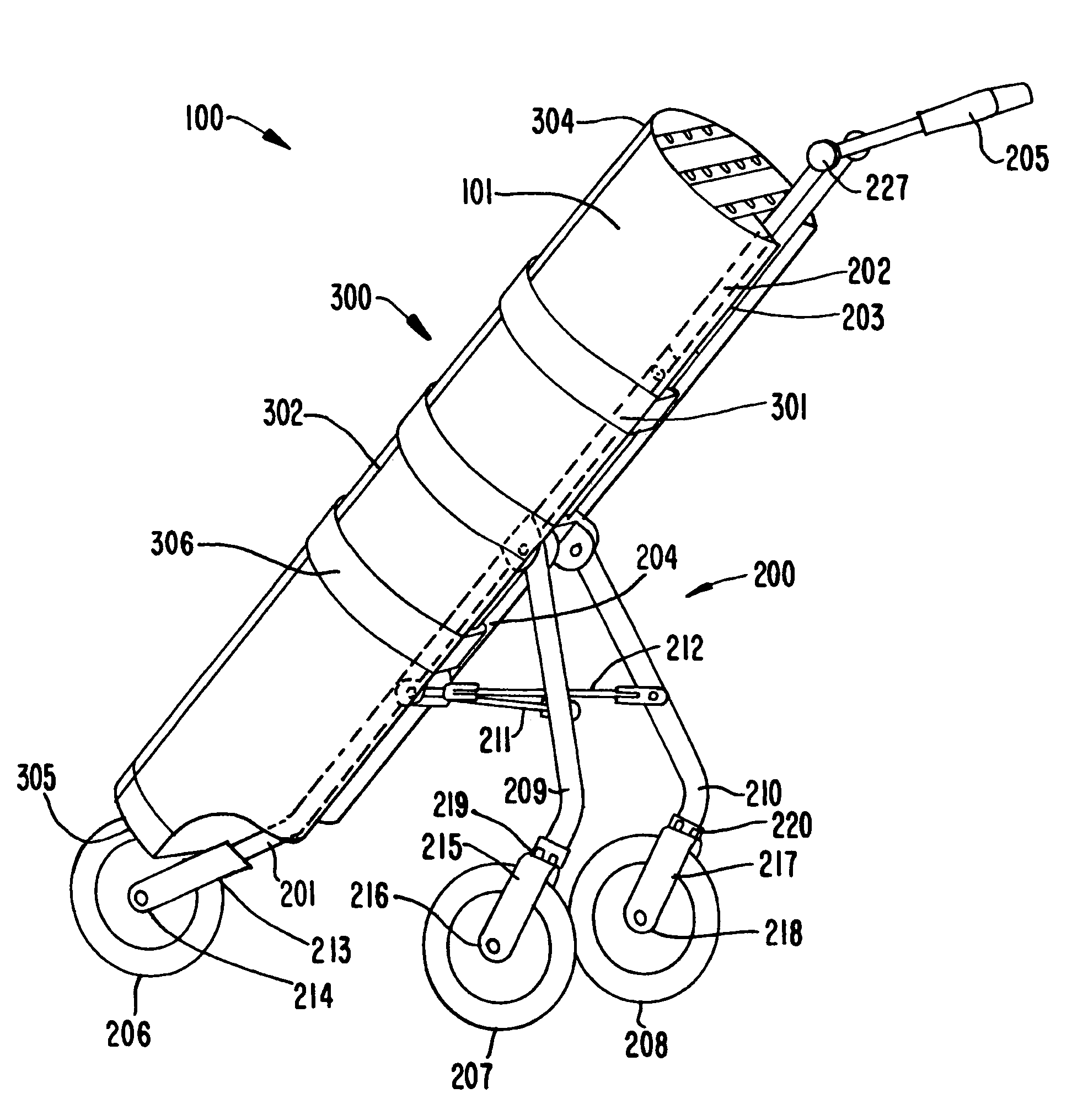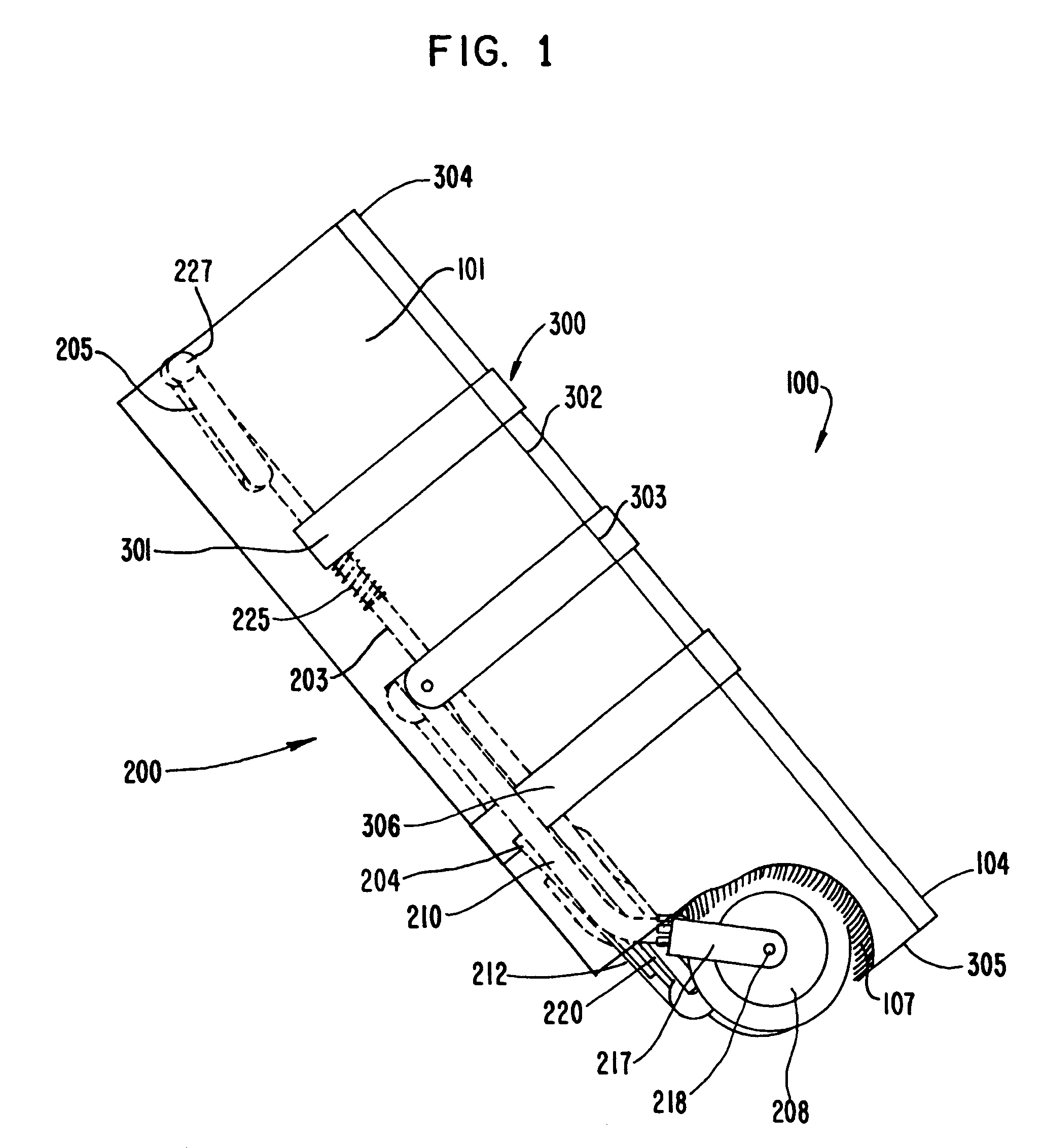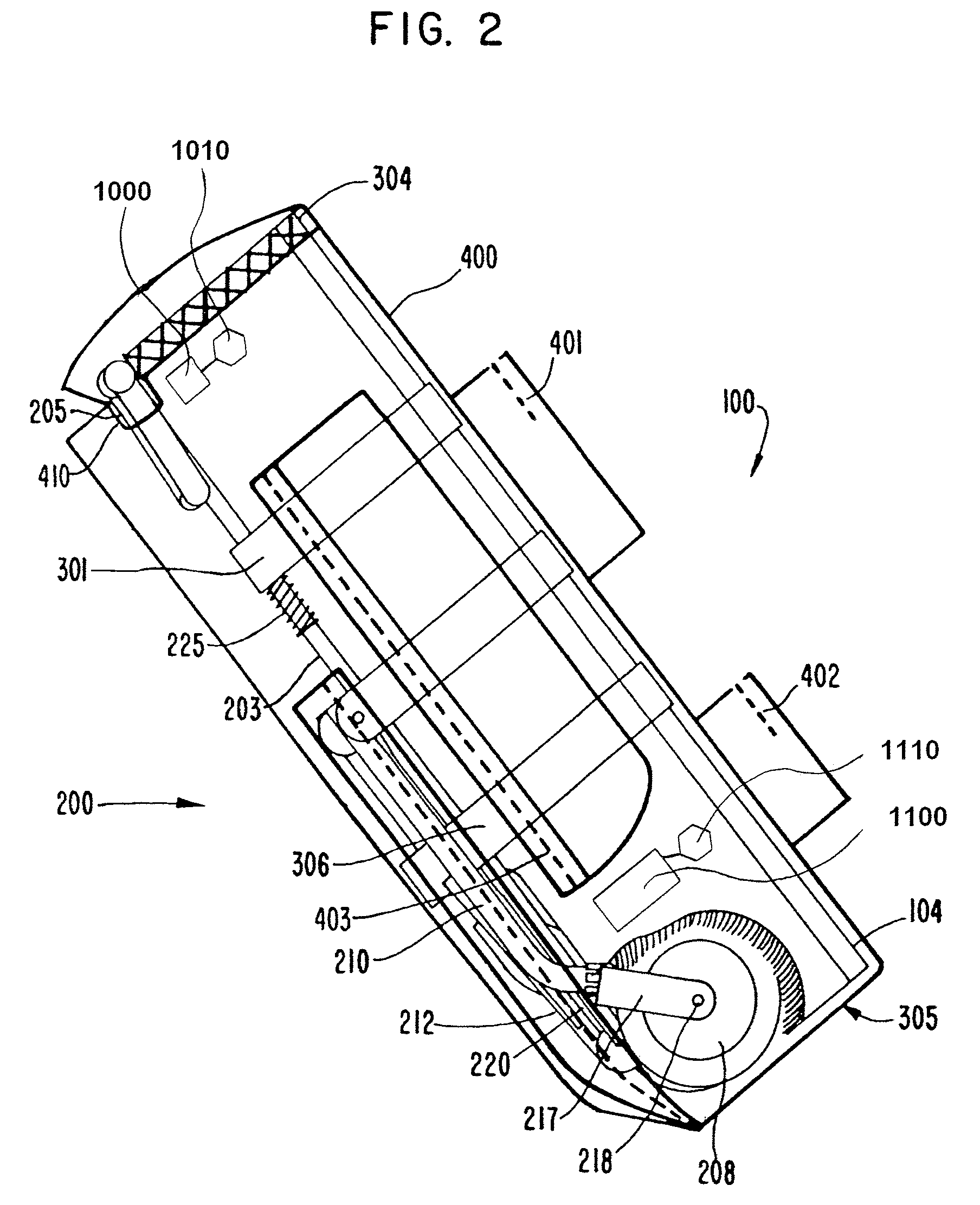The storage of clubs, golf accessories and personal items adds substantial weight to the golf bag and oftentimes creates a heavy load for the golfer to lift, move, carry or otherwise transport about the golf course.
A golfer must expend considerable physical effort, in addition to expense, to avoid the burdens imposed by manually lifting, carrying, moving or transporting the golf bag around a golf course.
Although wheels could be mounted to the base of a golf bag in a permanently fixed and exposed position, such wheels are awkward in appearance.
Moreover, such wheels can be hazardous, especially when a golfer inserts or removes the bag from the trunk or storage hatch of a vehicle, stores the bag, or tries to carry or otherwise move the golf bag rather than rolling it.
Golf bags with wheels in a permanently fixed and exposed position do not fit within the recessed areas of platforms attached to the rear of motorized carts.
Wheels in a permanently fixed and exposed position create a bulky and irregular shape that makes it difficult, to impossible, to store the golf bag in conventional storage racks, bins, lockers, trunks, platforms or other similar storage configurations typically found in and around golf courses and residences.
Additionally, golf bags with wheels in a permanently fixed and exposed position do not fit within traditional golf travel cover containers or systems.
Some golf bag designs have sought, in a less than elegant and practical fashion, to address the awkward appearance, difficulties in handling and storage, and operational hazards posed by wheels mounted on a bag in a permanently fixed and exposed position by making the wheels and their associated equipment detachable.
When the wheels and associated equipment are stored within the bag, they severely compromise the amount of space within the bag's club storage area.
It also impairs the golfer's ability to remove and re-insert clubs in the bag.
Furthermore, the golfer must expend considerable time and effort to attach the wheels and their associated equipment to the bag before initiating play, and to detach and store the wheels and their associated equipment after play is completed.
These modifications create an excessively bulky and deformed rolling bag that bears little resemblance to a traditional golf bag; is disproportionate in weight; difficult to maneuver; and not suitable for the transportation and storage of clubs, golf accessories and personal items.
Enlargements in the bag's length and circumference, in addition to the bag's outer compartments, also cause the bag to be so broad, that it cannot fit within the recessed areas of platforms attached to the rear of motorized carts.
Additionally, the bag is dimensionally incompatible with conventional storage racks, bins, lockers, trunks, platforms or other similar storage configurations typically found in and around golf courses and residences, and with traditional golf travel cover containers or systems.
Prior attempts to overcome the challenges posed by the incorporation of a transportation system into a traditionally shaped golf bag have not satisfactorily addressed all of these complications and shortcomings simultaneously.
Nonetheless, the wheel assembly platform of the '059 patent is completely and permanently exposed even in its retracted position.
Essentially, the '059 patent fails to disclose a golf bag where the integral transportation system can be fully retracted and stored within the golf bag when the system is not deployed and also fails to disclose a golf bag where the storage area for the integral transportation system does not require the height of the bag to be materially greater than the height of a traditional golf bag in order to maintain an adequate club storage space.
Additionally, the '059 patent fails to disclose a club support and suspension system that elevates shorter clubs above the lowest point of the golf bag, and restricts the movement of all clubs during transportation.
The wheel assembly mounted under the base of the bag in the '059 patent also increases the vertical dimension of the bag, and in turn, the effective height at which the clubs rest relative to the ground, thereby impeding or preventing the removal of clubs from the bag due to insufficient space between clubs and the roofing or foul weather systems typically found on motorized carts.
Essentially, the '527 patent fails to disclose a golf bag where the integral transportation system is fully retracted and stored within the golf bag when the system is not deployed.
The golf bag of the '527 patent will not function on a motorized cart, because the bag will not fit in the recessed areas of platforms attached to the rear of such carts.
Further, the wheels of the '527 patent, even when retracted, will tend to rotate off the motorized cart platform.
Additionally, the wheels attached to the bottom of a golf bag of the '527 patent extend the vertical dimension of the golf bag and preclude the placement of the bag in traditional storage systems and golf bag travel cover containers or systems.
The increased vertical dimension impedes or prevents the removal of clubs from the bag due to insufficient space between the clubs and the roofing or foul weather systems typically found on motorized carts.
The '527 patent fails to disclose a golf bag where the integral transportation system is concealed and stored within the golf bag when the system is not deployed and where the stowage area for the integral transportation system does not excessively impinge upon the interior storage area for clubs.
The '527 patent fails to disclose a club support and suspension system that elevates shorter clubs above the lowest point of the base or floor of the bag, restricts the movement of the grip ends of clubs during transportation, and includes perforations in the bottom panel to facilitate the ventilation of the club storage area and its drainage in the event of inclement weather.
The '006 patent does not appear to disclose a golf bag where the transportation system is integral to the bag, that requires no assembly or disassembly of component parts, and that remains intact and is stored within the golf bag when the system is not deployed.
Further, the '006 patent does not appear to disclose an integral transportation system that does not excessively impinge upon the interior storage area for clubs.
Indeed, the recessed well incorporated in the peripheral wall of the bag of the '006 patent appears to significantly reduce the club storage area within the interior of the bag, despite increases in the outer dimensions of the bag.
The '006 patent fails to disclose a golf bag where the integral transportation system fully retracts and is stored within the bag when the system is not deployed.
None of the previous golf bag assemblies provides adequate space for the storage of clubs, golf accessories and personal items, while providing an integral transportation system with wheels which are fully retractable and are stowed within the geometry of a traditional golf bag without significantly compromising the storage area for clubs, golf accessories and personal items.
None of the previous golf bag assemblies provides a support and suspension system for grip ends of clubs in the base or floor of the bag to minimize movement in the grip ends of clubs and thereby protect the clubs from contacting one another during transport, and also includes perforations in the bottom panel of the bag to ventilate the club storage area, to promote the drying of the grip ends of clubs and to drain the club storage area in the event of inclement weather.
 Login to View More
Login to View More  Login to View More
Login to View More 


